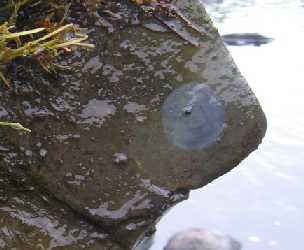Home → Water Quality → Monitoring & Reporting → Biomonitoring → Sampling & Analysis → River & Stream Algae
 Algae Sampling in Rivers & Streams
Algae Sampling in Rivers & Streams
Site locations & rationale
The Biological Monitoring Program has been sampling algae from rivers and streams distributed throughout the State of Maine since 1999. Sampling is usually performed between mid-June and the end of July. This time frame ensures that all sites are receiving approximately the same level of daily exposure to sunlight when they are sampled. Sampling during this time period also ensures that river and stream flow is no longer directly influenced by spring snow melt. Sampling is usually conducted in areas of moderate flow with little canopy cover.
Sampling methods
Viewing bucket survey This method provides an estimate of the amount of periphyton cover existing on the stream bottom at a given site. A viewing bucket with a clear bottom is used to record the length of filamentous algae and the thickness of periphyton mats. This process is repeated at multiple locations within a given site. Minimally disturbed streams usually have very little algal growth with thin, transparent layers on rocks and isolated patches of filamentous algae. Streams and rivers enriched with nutrients often have thick mats of algae smothering rocks and/or long strands of filamentous algae.
Natural substrate sampling This method of sampling focuses on epilithic algae, the type of algae that live on rocks, although plants and organic sediment can also be sampled when rocks and logs are not available habitat at a site.
Rocks are sampled along transects at the sampling site. A cobble-size rock is collected from the beginning, middle, and end of each transect. A circular rubber sampling device is placed on the rock to standardize the surface area of the sample. Algae are removed from the rock within the designated area (see the picture above). Algae from all rocks are pooled into one sample representing the entire site. A similar approach is used on logs when rocks are not available.
Epiphytic algae may also be sampled from plant clippings at a stream site. Emergent plant stems are clipped below the water line. Algae are removed from these stems and combined into one sample representing the entire site. The surface area of each stem is mathematically estimated and recorded to provide a more quantified sample.
If none of the above surfaces are available algae may be sampled from sand or other fine sediments. A Petri dish is inverted and placed into the sediment to obtain a "core" sample. An un-slotted spatula is then slid beneath the Petri dish to hold the sample in place as the dish is removed from the stream. The sediment from multiple cores is combined into one sample representing the entire site.
Artificial substrate sampling-This method of sampling provides a highly standardized estimate of the composition of an algal community in a river or stream. A periphytometer is submerged at the stream site for fourteen days to allow algal colonization of the microscope slides contained inside. The periphytometer is placed in an area of the stream where it will receive full sun and a normal rate of flow for that water body. Areas beneath heavy canopy, eddies, pools, and riffles are avoided to make placement of the sampling device as standardized as possible. After fourteen days the periphytometer is removed. One pair of slides is taken for analysis of chlorophyll a, while the algae on the other slides are used for taxonomic evaluation.
Data analysis
The algae in a sample are identified to the lowest practical taxonomic level. Diatoms are typically identified to species or subspecies level while green algae, red algae, cyanobacteria, and other algae are usually identified to genus or species level. The data are reported with cell densities (cells per unit area sampled) and cell biovolumes (micrometers per unit area sampled).
The Biological Monitoring Program is currently working on identifying the taxa (types of algae) that are usually found in minimally disturbed streams and the taxa that are tolerant of pollution, nutrient enrichment, and habitat disturbance. The sensitivity of taxa to these environmental stressors will be used to help identify whether a stream is healthy or degraded.
In addition, the Biological Monitoring Program is examining the composition, structure, and function of the community of algal taxa found in samples. This information will be used to define expectations for class A, B, and C streams and rivers. The Biological Monitoring Program is in the process of building a statistical model, similar to the one used for stream macroinvertebrates, that will be used to determine attainment of biological criteria.